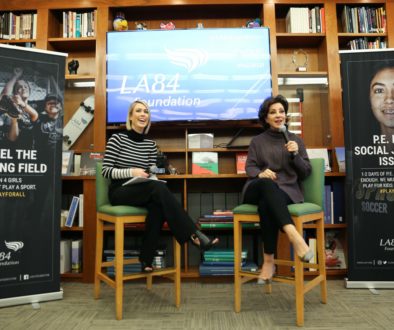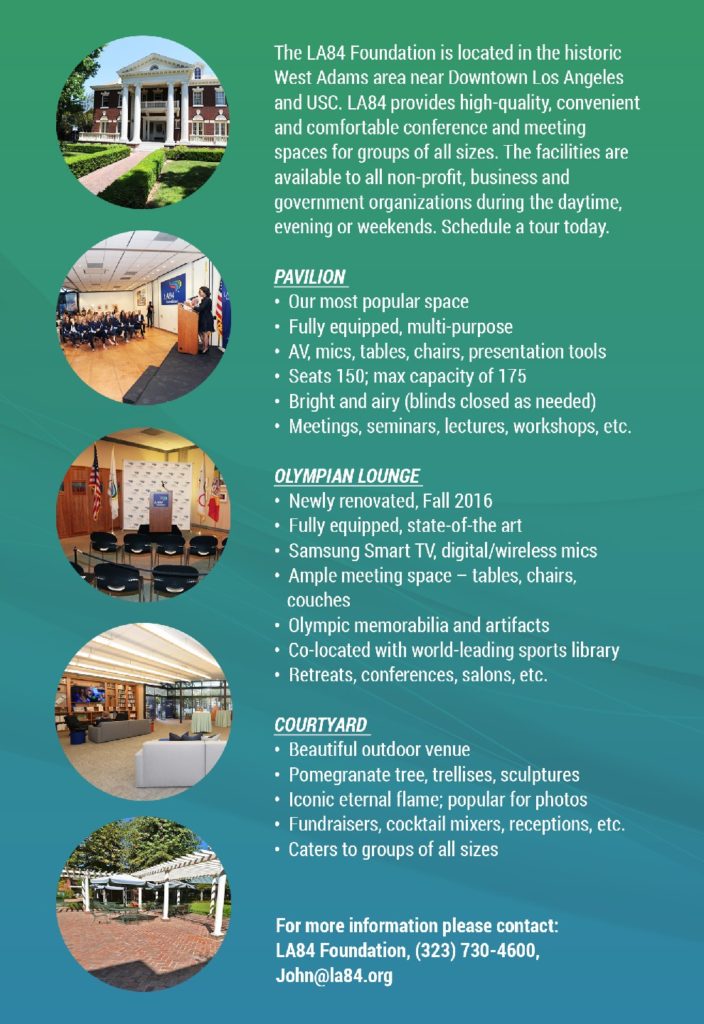SL Interview: Author Joe Drape Finds Perfection in Smith Center, Kansas
Smith Center is a small town (population: 1,931) located about four hours west of Kansas City and just minutes from the geographical center of the continental United States. What initially drew New York Times reporter Joe Drape to Smith Center is the high school football team: the Redmen have won 67 consecutive games, currently the longest winning streak in the nation.
In “Our Boys: A Perfect Season on the Plains with the Smith Center Redmen” (Times Books/Henry Holt; Amazon), Drape chronicles the season that he (and his wife and young son) spent in Smith Center during 2008. He writes about exchanging the fast-paced, urban stylings of New York City for life in a one-stoplight, Midwestern farming town. Wheat is the primary crop and the nearest McDonald’s is 90 miles away.
Swapping Wall Street for Main Street, Drape found himself rejuvenated by the experience. Smith Center, Drape writes, is a town where youth sports have become an integral part of a tight-knit community that values dedicated effort and teamwork. Led by Coach Roger Barta, the football team has provided years-long inspiration to the community; in turn, the community bonds together to nurture the kids. One example Drape cites: the players on the football team appear on a set of trading cards that are distributed to the kids at the elementary school. They must also sign a contract pledging to remain alcohol-, drug- and tobacco-free. If they violate that contract, their cards are revoked and they must explain to the elementary school students why they were booted from the team.
A Kansas native, Drape has worked at The Dallas Morning News and The Atlanta Journal-Constitution. Currently, he is a staff writer at the New York Times. He is the author of “Black Maestro: The Epic Life of an American Legend” (Morrow/HarperCollins), a biography of African-American jockey Jimmy Winkfield and the winner of the Castleton Lyons-Thoroughbred Times Book Award, and “The Race for the Triple Crown: Horses, High Stakes and Eternal Hope” (Grove Press). He is also the editor of a collection entitled “To the Swift: Classic Triple Crown Horses and Their Race for Glory” (St. Martin’s).
SportsLetter spoke with Drape by phone from his home.
— David Davis
SportsLetter: There’ve been many season-in-the-life books about sports teams and, in particular, high school sports teams, starting with “Friday Night Lights” and “In These Girls Hope Is a Muscle.” Were there any books that influenced you with “Our Boys”?
Joe Drape: “Friday Night Lights” is the gold standard — that and David Halberstam’s “Breaks of the Game” — because those books also transcend sports. Those have always been with me. What I wanted to do with “Our Boys” is what I think all of us do when we try to do these books: tell a story in which sports is the vehicle, but that isn’t just about sports.
SL: How did you get interested in Smith Center?
JD: I was coming back from covering the Eagles-Cowboys game when I read a brief in the paper about a football team scoring 72 points, in the first quarter, from Smith Center, Kansas. I grew up in Kansas City and I had never heard of Smith Center. To tell you how little I knew about them, the first time I called over there I asked them if they were playing “eight-man” ball. But I thought it was a story worth checking out. At the very least, I’d have a chance to visit with my family.
SL: Initially, you covered the Smith Center team on assignment with the New York Times. Why did you decide to write the book?
JD: I went there to do a story for the Times about the winning streak, and in three days I knew this was a book. And I never get that feeling. When I got home, I ripped the book proposal off in, like, two days.
This place really got under my skin. I felt that these were my kind of people. I’m from the area originally. I was a new father at the time, and that influenced me a lot. I thought: I grew up like this and I need to show my son something like this. I just had a feeling that this was a good place to explore the Midwest.
SL: You relocated your family to Smith Center. Why did you feel it was necessary to do that?
JD: When I conceived the book, I knew that we needed to move down there. It’s an isolated place in a different part of the world, a town of 1,900, and the nearest McDonald’s and Wal-Mart are 90 miles away. In order to see why this team is so important to the community, we needed to absorb the place. We needed to live like them.
It also goes back to the new fatherhood thing: I wanted my son to see grasshoppers. I wanted him to be able to go to a field and run unfettered. These are things that are impossible to do here.
SL: You write about the extraordinary link between the players, “Our Boys,” and the townspeople. How would you describe that relationship?
JD: It’s a community that, for generations, believes that it takes a village to raise a child. That may sound trite, but everybody there takes pride in each other’s kids. Everybody is somebody’s niece, nephew, uncle, grandparent. If you’re at the movie theater and a kid is jacking around, someone will say, “Hey, Billy, would your dad let you do that?”
SL: Why have high school sports become the lifeblood of the town?
JD: Because it’s really the only game in town. The high school is the biggest industry in Smith Center — it’s the largest employer by far — and it’s where the community is invested as a whole. So, take a guy like Jack Baentz: his kid hasn’t played there for 40 years. But you see him at the junior varsity games and the volleyball games. That is what’s there to do there.
Also, Coach Barta has gotten the community to buy in, and not just with football. It’s the whole athletic program. On summer nights, there’s 160 kids up there lifting weights or playing volleyball. Parents believe in that: they want to know where their kids are and they want them to be doing something.
SL: Does the town sustain the team or does the team sustain the town?
JD: It’s a very symbiotic relationship. Yes, the town sustains the team. The town comes out early for their tailgate events on Fridays. The town picks them up when they’re down. And then, the team creates this great community pride. They’re just that good. It’s unbelievable to see how they dominate teams bigger than them.
Having said that, it’s about more than the winning streak. It’s about supporting the kids every day. In other words, the town is not living and dying to win football games. They’re proud of the team, but not crazed about it. They’re just very interested in the kids doing well. They take just as big a pride in the kids taking part in Future Farmers of America.
SL: You write that most of the players from Smith Center don’t attend football camps, like many teens do during the summer, because they’re working on the family farm. Yet they manage to keep winning. How do they do this?
JD: Part of it is the preparation. They run a very simple offense – they basically run it up the gut – and they’ve run the same basic offense for 31 years. The freshmen knew all the plays on the first day of camp. The assistant coaches all played under coach Barta. Everybody knows the lingo; everybody knows what’s expected of them.
I think there’s also a generational work ethic that’s been part of Smith Center forever. Everybody is used to hard work. Every day, they get up mornings at five to do their chores. End of June and July, it’s harvest time. They know they have to bring the wheat in in about three weeks; working 16 hours a day, when a hail storm could come wipe out a million dollar’s worth of crops.
SL: Do you think that the youth athletes of Smith Center view sports differently than the rest of the nation?
JD: Yes, they do. Archie Manning told me once that he didn’t let his kids play any organized sports until high school. He said that kids should be getting among themselves, playing sandlot games, and that they should play all different sports.
That’s sort of the attitude you see in Smith Center. They’re all multi-sports athletes. They go from football to wrestling or basketball to track. This is their fun, their recreation, their entertainment. They study, they work, and then they play ball for a couple hours on Friday night. That’s as good as it gets.
These folks know that they’re not going to play Division I. They know that they’re not going to the Olympics. Most of them don’t want to leave Kansas. Frankly, that surprised me. Several of the players on the team are terrific students. They could go Ivy League or play at a place like Ohio Wesleyan. But they said, “I don’t want to leave home. I don’t want to go that far.” I think this relates to how they approach sports: they’re playing for something far greater than their personal gain.
Pretty much everywhere else, you have youth athletes specializing in one sport. Parents are sending their kids to golf camp or tennis camp or soccer camp. They devote their lives to their kid making a team and being a star.
SL: A major subplot of the book is that, going into the 2008 season, Smith Center was riding a four-year winning streak. Was it difficult for you to maintain your journalistic objectivity and not root for them to stay undefeated?
JD: Previously, I’d written a book about [horses competing for] the Triple Crown. One [horse I was following] won the first race, another horse won the second, and then neither one came to the third. So, I’ve had the worst-case scenario before [laughs].
Early in the season, Smith Center played Norton. This was a game they probably should have lost, but they won. It didn’t get under my skin, and I kept an even keel. But I make no pretext in the book that, by the end of the regular season, I really wanted them to win. I was truly rooting for them to do it. It’s going to sound trite, but it’s true: I wanted it for the seniors. I saw how the coaches worked with them, how they built them up, little by little, along the way. I saw them go from this unconfident lot who were scared of their own shadows to grow into this machine that was a thing of beauty.
SL: How important is the winning streak to the players and coaches and also to the community?
JD: They’re very proud of it. They want to preserve it. It’s a sort of an Excalibur – the legacy is handed down from senior class to senior class. There’s a great deal of responsibility not to be the senior class to lose it. At the same time, knowing these people now, I think that when they lose, it’ll be one of their finest moments. They’ll have a one heck of a party and give their kids standing ovations and hugs. They’ll tell them, “This means nothing. You guys are still our boys.”
SL: The head coach, Roger Barta, avoided talking directly about the winning streak. What’s his attitude about the streak?
JD: He told me that, when he was a young coach, he got lower than whale s— when he lost. He was just so into it. But as you mature and evolve, he said, you realize that you can only do the best that you can do, that you’re going to get beat. I think he wants the streak [to continue]; I think he wants to keep winning. He certainly thinks he’s going to win every game. And when you ask him, “What are you going to do when you lose?” he says, “Start another streak.”
SL: Why has he been so successful?
JD: I’ve dealt with [Mike] Krzyzewski and [Bobby] Knight. They’re magical guys. And, coach Barta is one of them. He gripped me. He’s a very straightforward guy. He never yells, he never screams, never talks about winning or losing. He just breaks things down in the simplest ways. The first time I was down there, he said. “Everybody does mundane things in life. The successful people are the ones that get a little bit better each day.”
SL: How would you describe his coaching philosophy?
JD: He’s the whole life coach. He has three fundamental tenets that apply to football and are also life lessons. First, it’s about competing. He tells them, “You oughta get used to competing, and you oughta enjoy it, because you’re going to be competing for the rest of your lives.” Second, it’s about getting a little bit better each day, that you got to work to be better than you were yesterday. The third thing he says is, “We’re going to out-hit and out-work them. They may quit the first ten minutes or the third quarter or in overtime, but they’re going to quit and we’re not gonna quit. We’re not ever gonna quit.”
His offense is a metaphor for his philosophy. He’s just going to pound you, pound you, pound you. Seven guys on the line, four in the backfield. He’s going to run it to the fullback 20 times a game, and he’s going to go off tackle twelve times because some of those off-tackle runs are going to break for 60-yard touchdowns. The thing is, he doesn’t make any pretext about what he’s going to do. Everybody knows what’s coming. They’ve been doing the same thing for years.
SL: Smith Center received much publicity, including your article in the New York Times and then pieces in Sports Illustrated and ESPN. Did that change the way the team prepared and the way coach Barta operated?
JD: Not at all. That’s what was extraordinary to watch during the season. They did it the same way they always do.
SL: The town of Smith Center and the students at the high school are predominantly white, and yet the sports teams are known as “The Redmen.” Did that strike you as odd?
JD: It did, but they’re not all that worried about political correctness around there. I asked them once, “How have you managed to stay this way?” They said, “About six years ago, we got a letter or two about it. We were prepared to change it if we had to, but it never picked up steam.”
SL: Do you think they should change their name, like the St. John Redmen becoming the Red Storm?
JD: Not at all. Maybe that’s going to get me in trouble, but they’re not demeaning anybody. Truly, that part of Kansas was Indian country, and there are Indians still around.
SL: What did you take away from living in Smith Center?
JD: Two things that I will take away from Smith Center forever, insight-wise. I hadn’t been around people who loved to play sports and compete in a long time, people who did it for the sheer joy of it, who did it for nothing. Maybe we’re too cynical these days, but that was inspiring to watch. The second thing was learning how much impact caring teachers and coaches can make, how noble they are. We forget that teachers change lives. In a community like Smith Center, these guys are front and center: they’re your teacher, your coach, your buddy’s father. It made me think about all the teachers who helped me along the way.
SL: You followed the team during the fall of 2008, and the book is out in time for the 2009 season. How did you manage to do such a quick turnaround with all the material you accumulated?
JD: The last book I did [about jockey Jimmy Winkfield] took four years of research and writing. It was a great project and I learned a lot, but I didn’t want to do another one of these things. This project captured my heart. I just had such a sense of the material; I’ve never written this fast before. And, I already had a template – the spine was the season – with a built-in beginning, middle and end.
SL: The subtitle of the book — “a perfect season” — removes any suspense of whether the team would go undefeated in 2008. Were you okay with that?
JD: I’m the one who suggested it. My thought was, in this day and age, everybody knows everything. Everybody knows that Smith Center has the longest winning streak in the nation. Second, I don’t really think the book is about the winning streak. To me, “perfect” isn’t about being 13-0. We had a perfect year there.




